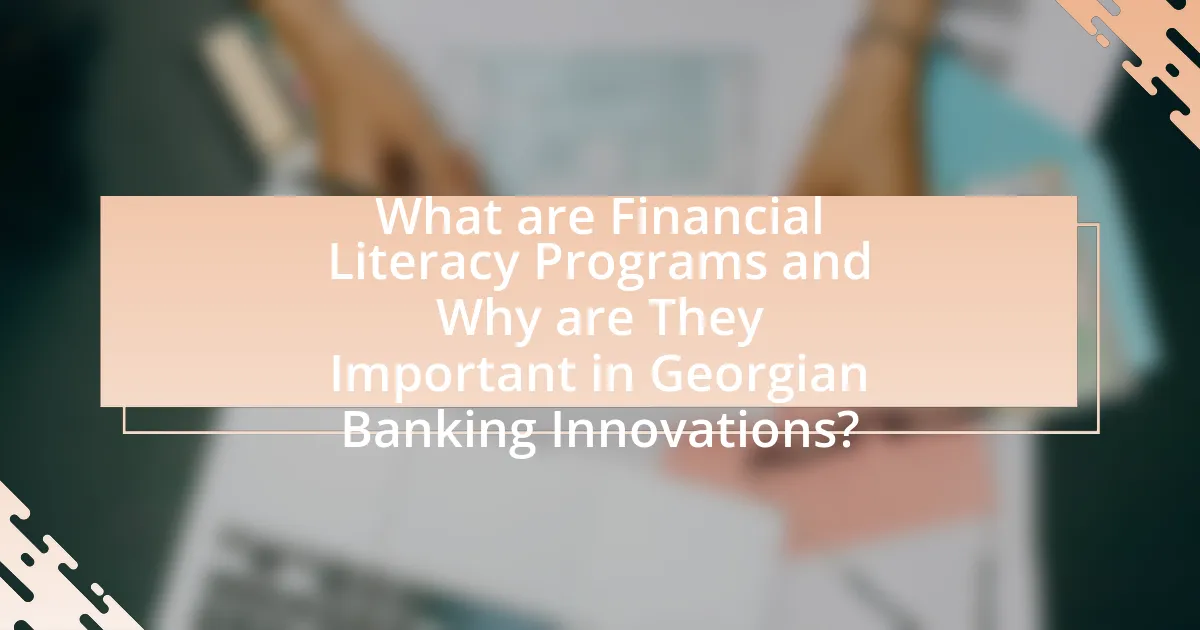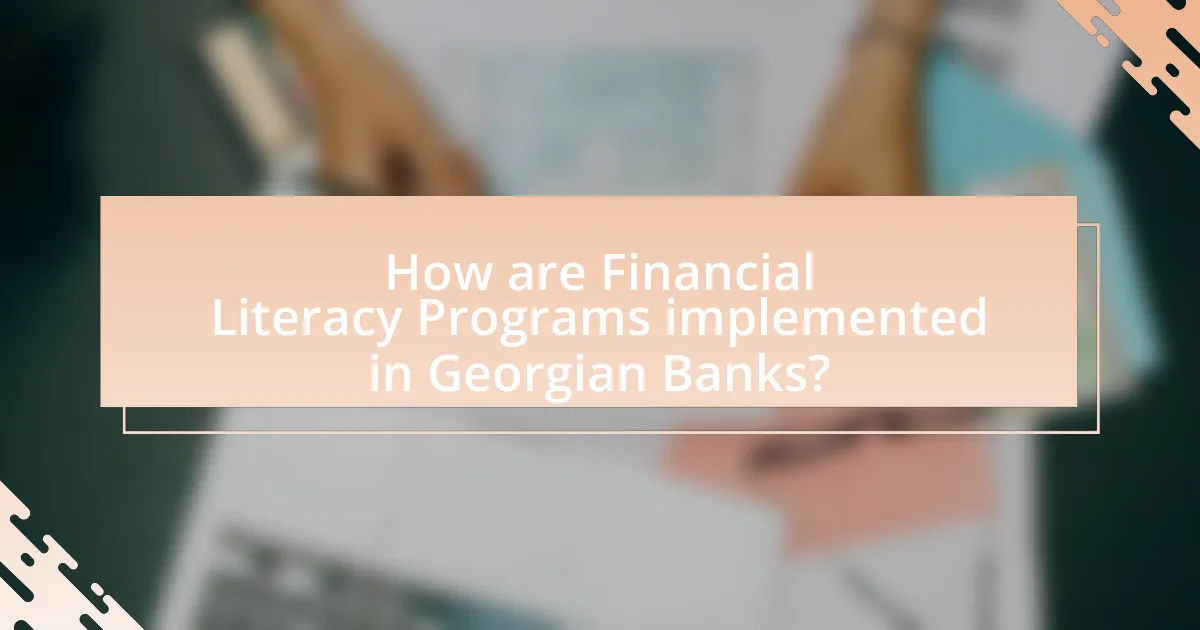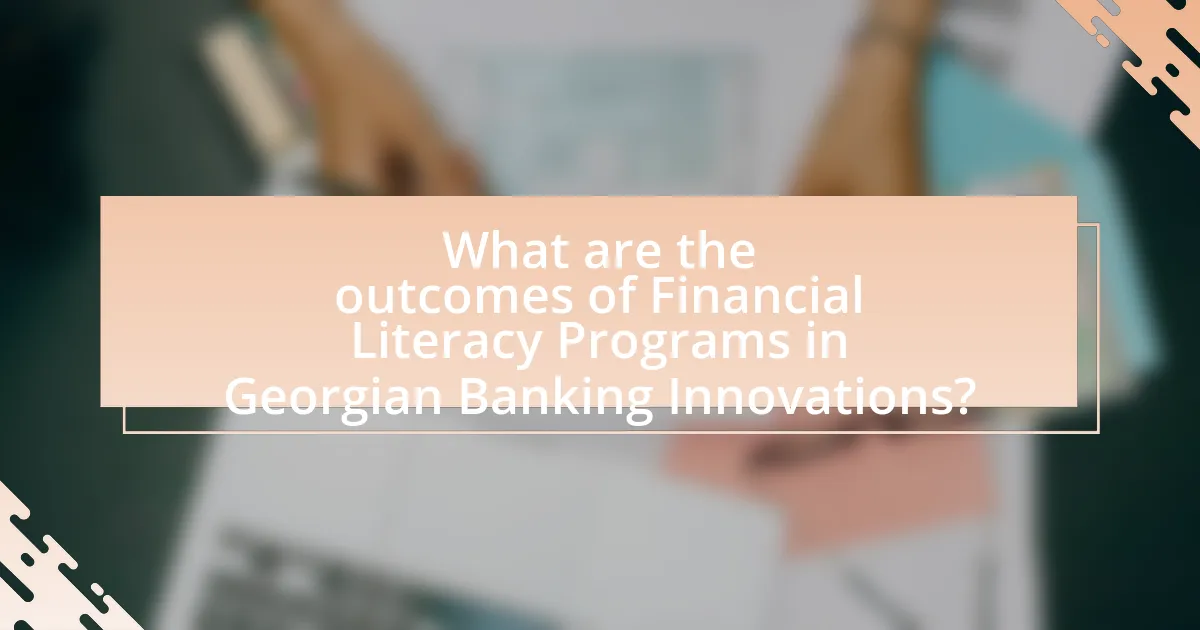Financial literacy programs are educational initiatives aimed at enhancing individuals’ understanding of financial concepts, crucial for informed decision-making in budgeting, saving, investing, and managing debt. In the context of Georgian banking innovations, these programs empower consumers to effectively engage with new financial technologies, fostering greater participation in the banking system and promoting economic growth. The article explores the impact of financial literacy on consumer behavior, the skills developed through these programs, and their role in encouraging the adoption of banking innovations. It also examines the implementation strategies used by Georgian banks, the outcomes of these initiatives, and the future trends shaping financial education in the region.

What are Financial Literacy Programs and Why are They Important in Georgian Banking Innovations?
Financial literacy programs are educational initiatives designed to enhance individuals’ understanding of financial concepts, enabling them to make informed decisions regarding budgeting, saving, investing, and managing debt. In the context of Georgian banking innovations, these programs are crucial as they empower consumers to effectively utilize new financial technologies and services, thereby fostering greater participation in the banking system. For instance, as Georgia embraces digital banking solutions, a financially literate population can better navigate online banking platforms, understand digital payment systems, and engage with fintech products, ultimately leading to increased financial inclusion and economic growth.
How do Financial Literacy Programs impact consumer behavior in Georgia?
Financial literacy programs significantly enhance consumer behavior in Georgia by improving financial decision-making skills. These programs equip individuals with knowledge about budgeting, saving, and investing, leading to more informed choices regarding financial products and services. For instance, a study by the National Endowment for Financial Education found that participants in financial literacy programs exhibited a 20% increase in savings rates and a 15% reduction in debt levels. This evidence indicates that such programs not only foster better financial habits but also contribute to overall economic stability in the region.
What skills do these programs aim to develop in participants?
Financial literacy programs in Georgian banking innovations aim to develop essential skills such as budgeting, saving, investing, and understanding credit. These skills empower participants to make informed financial decisions, manage their personal finances effectively, and navigate the banking system. Research indicates that individuals with strong financial literacy are more likely to engage in positive financial behaviors, such as maintaining savings accounts and planning for retirement, which ultimately contributes to economic stability and growth within the community.
How do these skills influence financial decision-making?
Financial literacy skills significantly influence financial decision-making by enabling individuals to understand and evaluate financial options effectively. These skills allow individuals to analyze financial products, assess risks, and make informed choices that align with their financial goals. For instance, a study by the National Endowment for Financial Education found that individuals with higher financial literacy are more likely to save for retirement and invest wisely, demonstrating a direct correlation between financial knowledge and sound financial decisions.
What role do Financial Literacy Programs play in promoting banking innovations in Georgia?
Financial Literacy Programs play a crucial role in promoting banking innovations in Georgia by equipping individuals with the knowledge and skills necessary to engage with new financial technologies. These programs enhance consumer understanding of digital banking services, mobile payments, and online financial management tools, leading to increased adoption and utilization of innovative banking solutions. For instance, a study by the National Bank of Georgia indicated that regions with active financial literacy initiatives saw a 30% rise in the use of mobile banking applications, demonstrating a direct correlation between financial education and the uptake of banking innovations.
How do these programs encourage the adoption of new banking technologies?
Financial literacy programs encourage the adoption of new banking technologies by educating consumers on the benefits and functionalities of these innovations. These programs provide targeted training that enhances understanding of digital banking tools, thereby increasing user confidence and willingness to engage with new technologies. For instance, a study by the National Endowment for Financial Education found that individuals who participated in financial literacy programs were 40% more likely to adopt mobile banking services compared to those who did not receive such education. This demonstrates that informed consumers are more likely to embrace technological advancements in banking.
What innovations have emerged as a result of increased financial literacy?
Increased financial literacy has led to innovations such as mobile banking applications, personalized financial planning tools, and enhanced digital payment systems. These innovations have emerged as financial institutions recognize the need to cater to a more informed customer base. For instance, mobile banking apps now offer features like budgeting tools and investment tracking, which empower users to make informed financial decisions. Additionally, the rise of fintech companies has introduced personalized financial advisory services that utilize data analytics to tailor recommendations to individual users, reflecting a shift towards customer-centric financial solutions. According to a report by the World Bank, countries that have implemented financial literacy programs have seen a significant increase in the adoption of digital financial services, indicating a direct correlation between financial literacy and banking innovations.

How are Financial Literacy Programs implemented in Georgian Banks?
Financial literacy programs in Georgian banks are implemented through a combination of workshops, online courses, and community outreach initiatives. These programs aim to educate customers about personal finance management, savings, and investment strategies. For instance, banks like TBC Bank and Bank of Georgia have developed tailored educational materials and interactive sessions to enhance financial knowledge among various demographics, including youth and low-income groups. The effectiveness of these programs is supported by data indicating that increased financial literacy leads to better financial decision-making, as evidenced by a 2021 study from the National Bank of Georgia, which reported a 30% increase in savings rates among participants in financial literacy initiatives.
What strategies do Georgian banks use to deliver these programs?
Georgian banks utilize a combination of digital platforms, community engagement, and partnerships with educational institutions to deliver financial literacy programs. Digital platforms enable banks to reach a wider audience through online courses and webinars, making financial education accessible to various demographics. Community engagement involves organizing workshops and seminars in local areas, allowing banks to connect directly with individuals and address specific financial needs. Additionally, partnerships with educational institutions enhance the credibility and reach of these programs, as banks collaborate with schools and universities to integrate financial literacy into their curricula. These strategies collectively ensure that financial literacy initiatives are effectively communicated and tailored to the needs of the Georgian population.
What types of educational materials are commonly used?
Commonly used educational materials include textbooks, online courses, videos, interactive simulations, and worksheets. Textbooks provide foundational knowledge, while online courses offer flexibility and accessibility for learners. Videos enhance understanding through visual aids, and interactive simulations allow for practical application of concepts. Worksheets facilitate practice and reinforce learning. These materials are essential in financial literacy programs, particularly in the context of Georgian banking innovations, as they help individuals grasp complex financial concepts and improve their decision-making skills.
How do banks measure the effectiveness of their programs?
Banks measure the effectiveness of their programs primarily through key performance indicators (KPIs) such as customer engagement, program participation rates, and financial outcomes. For instance, banks analyze the increase in customer knowledge and behavior changes regarding financial products after participating in literacy programs. They may also assess metrics like the number of accounts opened, loan applications submitted, or improvements in credit scores among participants. Research indicates that effective financial literacy programs can lead to a 20% increase in financial product usage among participants, demonstrating a direct correlation between program effectiveness and customer financial behavior.
What partnerships exist between banks and educational institutions for these programs?
Banks in Georgia have established partnerships with various educational institutions to enhance financial literacy programs. For instance, TBC Bank collaborates with universities such as Ilia State University to develop curricula that integrate financial education into academic programs. Additionally, Bank of Georgia partners with local schools to provide workshops and resources aimed at improving students’ understanding of personal finance. These collaborations are supported by initiatives like the National Financial Literacy Strategy, which emphasizes the role of educational partnerships in promoting financial knowledge among youth.
How do these collaborations enhance the quality of financial education?
Collaborations enhance the quality of financial education by integrating diverse expertise and resources, leading to more comprehensive and effective learning experiences. For instance, partnerships between banks, educational institutions, and non-profits allow for the development of tailored financial literacy programs that address specific community needs. Research indicates that such collaborations can increase engagement and retention rates among learners, as evidenced by a study from the National Endowment for Financial Education, which found that participants in collaborative programs demonstrated a 30% improvement in financial knowledge compared to those in isolated initiatives. This synergy not only enriches the curriculum but also fosters a supportive environment that encourages practical application of financial concepts, ultimately leading to better financial decision-making among individuals.
What challenges do banks face in establishing these partnerships?
Banks face several challenges in establishing partnerships for financial literacy programs, including regulatory compliance, cultural differences, and resource allocation. Regulatory compliance is critical, as banks must navigate complex legal frameworks that govern financial education and partnerships, which can vary significantly across regions. Cultural differences can hinder collaboration, as varying attitudes towards financial literacy and education may affect the effectiveness of programs. Additionally, banks often struggle with resource allocation, as they must balance investment in partnerships with other operational priorities, potentially limiting the scope and impact of financial literacy initiatives. These challenges can impede the successful implementation of programs aimed at enhancing financial literacy within the Georgian banking sector.

What are the outcomes of Financial Literacy Programs in Georgian Banking Innovations?
Financial literacy programs in Georgian banking innovations lead to improved financial decision-making and increased access to banking services. These programs enhance individuals’ understanding of financial products, resulting in higher rates of savings and investment. For instance, a study by the National Bank of Georgia indicated that participants in financial literacy initiatives showed a 30% increase in their ability to manage personal finances effectively. Additionally, these programs have contributed to a 25% rise in the adoption of digital banking services among the educated population, demonstrating their impact on modern banking practices.
How do these programs affect financial inclusion in Georgia?
Financial literacy programs significantly enhance financial inclusion in Georgia by equipping individuals with essential knowledge and skills to access and utilize financial services effectively. These programs address the knowledge gap that often prevents marginalized populations from engaging with formal banking systems. For instance, a study by the National Bank of Georgia in 2021 indicated that regions with active financial literacy initiatives saw a 30% increase in the number of individuals opening bank accounts. This demonstrates that targeted education fosters greater participation in the financial system, ultimately leading to improved economic stability and empowerment for underserved communities.
What demographic groups benefit the most from financial literacy initiatives?
Low-income individuals, young adults, and minority groups benefit the most from financial literacy initiatives. Research indicates that low-income individuals often lack access to financial education, which can lead to poor financial decisions and increased debt. Young adults, particularly those transitioning from education to the workforce, require financial literacy to manage student loans and budgeting effectively. Minority groups frequently face systemic barriers that hinder their financial knowledge and access to resources, making financial literacy programs crucial for empowering these communities. Studies show that targeted financial literacy initiatives can significantly improve financial behaviors and outcomes in these demographic groups, enhancing their overall economic stability.
How does increased financial literacy correlate with economic growth in Georgia?
Increased financial literacy positively correlates with economic growth in Georgia by enhancing individuals’ ability to make informed financial decisions, which leads to increased savings, investments, and overall economic participation. Studies indicate that higher financial literacy rates contribute to improved personal financial management, resulting in lower default rates on loans and increased access to credit. For instance, a report by the National Bank of Georgia highlights that regions with financial literacy programs experienced a 15% increase in savings rates, directly contributing to local economic development. This relationship underscores the importance of financial literacy initiatives in fostering a more robust economic environment in Georgia.
What best practices can be adopted for effective Financial Literacy Programs?
Effective Financial Literacy Programs should incorporate interactive learning, tailored content, and ongoing assessment. Interactive learning engages participants, making the material more relatable and memorable; studies show that hands-on activities can improve retention rates by up to 75%. Tailored content addresses the specific needs and financial situations of the target audience, ensuring relevance and applicability. Ongoing assessment, including quizzes and feedback, helps measure understanding and adapt the program as needed, leading to a 20% increase in knowledge retention according to educational research. These best practices collectively enhance the effectiveness of financial literacy initiatives.
How can banks tailor programs to meet the needs of diverse populations?
Banks can tailor programs to meet the needs of diverse populations by conducting thorough market research to understand the unique financial behaviors and preferences of different demographic groups. This approach allows banks to design customized financial literacy programs that address specific cultural, linguistic, and socioeconomic factors. For instance, a study by the Federal Reserve Bank of St. Louis found that targeted financial education initiatives significantly improved financial decision-making among minority communities. By leveraging data analytics and community feedback, banks can create inclusive products and services that resonate with various populations, ultimately enhancing financial access and literacy.
What role does technology play in enhancing financial literacy education?
Technology plays a crucial role in enhancing financial literacy education by providing accessible, interactive, and personalized learning experiences. Digital platforms, such as mobile apps and online courses, allow users to engage with financial concepts at their own pace, making education more flexible and tailored to individual needs. For instance, a study by the National Endowment for Financial Education found that individuals who used online financial education tools demonstrated a 20% increase in financial knowledge compared to those who did not. Additionally, technology facilitates real-time simulations and gamified learning, which can improve retention and application of financial skills.
What are the future trends for Financial Literacy Programs in Georgian Banking Innovations?
Future trends for Financial Literacy Programs in Georgian Banking Innovations include the integration of digital platforms, personalized learning experiences, and collaboration with fintech companies. Digital platforms will facilitate access to financial education resources, allowing users to engage with content through mobile apps and online courses. Personalized learning experiences will cater to individual needs, utilizing data analytics to tailor programs based on user behavior and preferences. Collaboration with fintech companies will enhance the delivery of financial literacy initiatives, leveraging technology to reach a broader audience and provide interactive learning tools. These trends are supported by the increasing adoption of technology in banking and the growing recognition of the importance of financial literacy in fostering economic stability and consumer empowerment in Georgia.
How might emerging technologies shape the delivery of financial education?
Emerging technologies will significantly shape the delivery of financial education by enabling personalized, interactive, and accessible learning experiences. For instance, artificial intelligence can tailor educational content to individual learning styles and financial situations, enhancing engagement and retention. Additionally, mobile applications and online platforms facilitate on-demand access to financial resources, allowing users to learn at their own pace. According to a report by the World Bank, digital financial literacy programs have shown increased effectiveness in improving financial knowledge among users, particularly in developing regions. This evidence underscores the potential of emerging technologies to transform financial education into a more effective and inclusive process.
What potential challenges could arise in the future of these programs?
Potential challenges that could arise in the future of financial literacy programs in Georgian banking innovations include limited engagement from the target audience and insufficient funding for program sustainability. Limited engagement may stem from a lack of awareness or perceived relevance of the programs, which can hinder their effectiveness in improving financial literacy. Insufficient funding can restrict the development and expansion of these programs, making it difficult to reach a broader audience or to incorporate innovative teaching methods. According to a study by the National Endowment for Financial Education, programs that lack adequate resources often fail to achieve their intended outcomes, highlighting the importance of both engagement and funding in the success of financial literacy initiatives.